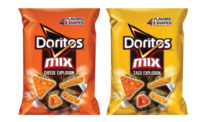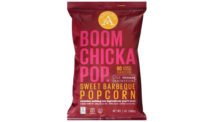Americans continue to crave Mexican food—so much so that they spend billions of dollars annually at quick-service restaurants like Taco Bell and Chipotle Mexican Grill and on Mexican foods at their local grocery store.
Overview | Bread | Tortillas | Sweet Goods | Snack Cakes | Pizza | Desserts | Cookies | Buns & Rolls | Bars | Breakfast Products
“The tortilla industry is constantly growing and adapting to the changing population and culture,” says Tim Romero, product sales manager, Taconic, Petersburgh, NY. “Tortillas have become a staple in most households and have evolved over the past decade to encompass a wide field of consumers. The technology involved in the tortilla-making process continues to expand and has increased the efficiency and capability to produce at the large volumes required today.”
The popularity of tortillas has exploded in all distribution channels—retail, industrial and foodservice, according to Julie Nargang, vice president of marketing/innovation, Azteca Foods Inc., Chicago. “This is synergistic with the continued popularity of Hispanic foods, as well as being a perfect vessel for other ethnic cuisines,” she explains.
Nargang cites several other trends also driving the growth of tortillas: continued growth of small-plate meals featuring a tortilla is the food carrier, customization of family meals and the addition of taco bites and street tacos to restaurant menus.
“Over the past year, we’ve continued to see strong consumer demand for flour tortilla products, both organic and gluten-free,” says Sam Garfinkel, category manager, Rudi’s Organic Bakery, Boulder, CO. “We believe this is because of their versatility. Tortillas can be found at many eating occasions and accompanying various cuisines.”
Market data
Data from IRI, Chicago reveals that consumers spent $2.33 billion on hard/soft tortillas/taco kits and $105.19 million on refrigerated tortillas during the 52 weeks ending April 17, 2016.
The hard/soft tortillas segment saw dollar sales growth of 3.83 percent. But sales of refrigerated tortillas dropped for the second year in a row, according to IRI. For the 52 weeks ending April 17, the segment was down 5.11 percent in dollar sales. The segment saw a similar sales decrease—5.08 percent—for the 52 weeks ending April 19, 2015.
In the hard/soft tortillas/taco kits segment, El Milagro Tortillas saw the largest dollar sales increase for the period—up 12.15 percent to $40.5 million. Gruma and Ole Mexican Foods each saw similar sales increases, to 6.83 and 6.86 percent, respectively. Gruma remains far and away the category leader, accounting for $1.10 billion in sales for the period.
Several manufacturers saw sales of hard/soft tortillas/taco kits decrease slightly, but Kraft Foods Group saw dollar sales in this segment drop significantly, falling 18.6 percent.
While most companies operating in refrigerated tortilla saw a drop, there were some bright spots. San Diego Tortillas saw the largest percentage sales increase—56.2 percent—recording $2 million in sales for the 52-week period. Tyson Foods, which owns several tortilla brands, saw its refrigerated tortilla sales jump 15.68 percent to $25.3 million. One emerging area of refrigerated tortillas is uncooked products finished by the consumer at home for peak freshness. Shoppers attracted to clean-label products might also find better resonance with refrigerated tortillas.
Looking back
Consumer demand for healthier and organic ingredients, ancient grains, gluten-free formulations and innovative flavors continue to spur development in the tortilla category.
“In 2016, we continue to focus on our No Artificial Preservative line, getting the message out and increasing consumer awareness of the healthier options available to them in the refrigerated section,” explains Nargang. “This is supported by consumers continuing to look for shortened ingredient decks and foods that do not include artificial preservatives, colors or flavors. The number of consumers looking for these better ingredients is continuing to grow year over year.”
Allied Blending and Ingredients, part of Solvaira Specialties, Keokuk, IA, is seeing more demand for clean-label products, too, says Dave Waters, director of business development. “It’s becoming more pervasive,” he says, adding that such products are now moving from retailers specializing in such goods to mainstream outlets, such as grocery stores. He adds, though, that “clean-label” can mean different things to different people.
“We’ve come out with a few clean-label formulations for customers that meet the requirements of retailers, who are really driving this trend,” Waters says. “It’s important to note that when you’re working with batch packs or formulas, you’re kind of constrained in which ingredients you can use and how much you can use, but it still has to taste good and perform for the customer.”
Ryan Barnett, insights manager, foods, Corbion Caravan, Lenexa, KS, says “organic in the in-store bakery and commercial aisles is becoming a factor, as both are experiencing very strong growth.” He adds that in the commercial aisle, no-preservative and non-GMO claims are also “trending very positive.”
Rudi’s Organic Bakery and Rudi’s Gluten Free Bakery offer a full lineup of organic and gluten-free flour tortillas and wraps. Rudi’s Organic Bakery line of wraps and tortillas includes Organic 7 Grain with Flax Wraps, Multigrain Wraps, Spelt Tortillas and Whole Spelt Tortillas. Rudi’s Gluten-Free Bakery tortillas are available in Fiesta, Plain and Spinach. All of the company’s flour tortillas are also dairy-free and made with non-GMO ingredients.
“Our gluten-free flour tortillas continue to be very popular with those who have celiac disease or a gluten intolerance,” says Garfinkel. “They are also popular among people who choose to eat a gluten-free diet. When it comes to flour tortillas, we continue to see increased demand for organic options, as consumers care more about what’s in their food.”
Better-for-you tortillas often require equipment considerations. “The health craze continues, and manufacturers want to make nonconventional and dozens of variations of more healthy and flavored alternative tortillas,” says Mark Van Drunen, president, AM Manufacturing, Munster, IN. “Many of these products require experience to be able to adjust settings on the equipment to run as efficiently as standard tortillas do. Manufacturers need to find equipment suppliers that are willing able to run all these new tortilla formulas.”
As with all baked goods, flavor trends continue to influence tortillas manufacturers. According to Barnett, traditional flavors like regular and yellow corn continue to lead the tortilla category in the commercial aisle, but unique flavors have also emerged. “Flavors such as Chipotle Chicken, Baja Fish and Beef Carne Asada have entered the category, while older flavor combinations like Rosemary & Thyme and Garlic & Herb have begun declining,” he notes. In the in-store bakery, he says traditional flavors such as plain, white, wheat and garlic continue to dominate the category.
Tumaro’s, Providence, RI, added five new flavorful products to its lineup this past winter. Chipotle Black Bean, Mesquite and Blue Corn joined its Tex-Mex Style Tortillas line, while a spicy Sriracha flavor joined its Low-in-Carb low-calorie wraps line. It also bulked up the protein to 8 grams in its new Low-in-Carb Premium White Protein Wrap.
“Tortillas are not a ‘one-size-fits-all’ category anymore,” says Romero. “Offerings from flavor to size to ingredients have helped grow and expand this industry to reach new customers.”
Looking forward
Long-time tortilla manufacturers are no doubt a bit amazed at how the tortilla has changed over the years, morphing from a simple corn or flour flatbread used in Hispanic dishes to a vegetable-flavored wrap that serves as a carrier for a variety of ethnic foods. And its transformation will likely continue as consumer demands change.
Nargang sees new directions in flavor, grains and healthier alternatives, while Garfinkel expects to see continued high demand for gluten-free and organic flour tortilla options.
“We see opportunities with the continued addition of unique and exotic flavors,” says Barnett. “This is a great way to keep the category fresh. We’re also seeing experimentation of new grains or grain blends as an area of opportunity.”
Consumer interest in, and awareness of, fresh products will also continue to impact the tortilla industry. According to Criss K. Cruz, president and CEO, Mi Rancho Tortillas Inc., Clovis, CA: “The tortilla industry is trying to learn and understand fresher products. No matter what specialty products we have in the industry, the consumer is going to gravitate toward a fresher, quality product.” He notes that consumers are looking for the best-quality product at the best value possible.
Cruz says consumers’ desire to purchase fresh tortillas at their local grocer is the same as when they shop for other foods. “When we go to the grocery store to buy meat or produce, we’re always trying to buy the freshest meat or produce, so it’s satisfying to consume when we take it home,” he maintains.
Cruz cites logistics and everyone along the supply chain—farmers, ingredient suppliers, vendors, manufacturers, retailers—as impacting the freshness of tortillas available at retailers. “The standards and practices are evolving,” he says. “The product types are evolving, too. Ultimately, the product is going to respond based on quality and how quickly retailers can get it into the consumer’s home.”
All of this tortilla innovation bodes well for the future of the market. “The tortilla industry continues to be the fastest-growing category in the baking industry,” says Romero. “The addition of tortillas to more menus will continue to drive this trend. The specialty market will continue to expand its offerings of organic and health-oriented products.”
Overview | Bread | Tortillas | Sweet Goods | Snack Cakes | Pizza | Desserts | Cookies | Buns & Rolls | Bars | Breakfast Products











